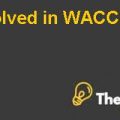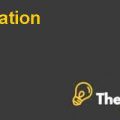
Valuation based on discounted cash flows (DCF)
The discounted cash flows is analyzed in order to determine the net worth of Saxon Financial both with synergies and without synergies. To evaluate the DCF analysis, WACC is calculated as company has done all its financing through equity (100%) therefore, there is no long-term and short-term debt. The Weighted Average Cost of Capital (WACC) is 8.26%.
There was an increase and decrease in the revenue from the year 2008 to 2012 as mentioned in the case whereas; EBITDA was expected to be 45% of the total revenue. In addition to this, the tax rate is 34.5% and the growth rate for the terminal value is 4%. However, the terminal value including the impact of synergies is $488.65 million while the enterprise calculated value is $604.53 million. Moreover, the total numbers of shares that Saxon Financial issued are around $13.67 million and this amount is divided by the enterprise value in order to determine the value per share of Saxon Financial. The value per share of Saxon Financial without synergies is $44.22 million.
Additionally, after evaluating the discounted cash flows (DCF) without the impact of synergies, DCF is calculated with synergies. However, the main difference while evaluating the discounted cash flows (DCF) with the impact of synergies is the addition of expected saving of around $5 million in case of merger or acquisition. The terminal value with synergies increases to $568.60 million whereas, enterprise increases to $705.39 million.
The terminal value increased by $79.95 million while total enterprise value is increased by $100.85 million. The value per share of Saxon Financial including synergies is $51.60 million that is calculated by dividing the total shares by enterprise value. In addition to this, the value per share of Saxon Financial would also increase with synergies to $7.38 million.
Valuation based on comparable analysis
The other method which has been used for the valuation of Saxon Financials is through comparable companies’ analysis. The particular method requires the comparison of the financial values and analysis against companies which are the direct competitors for a particular company and which has similar attitudes in the industry. For the particular case, limited data was provided which could be directly compared with the data of Saxon Financials. The comparison results in the better position of Saxon Financials while considering the value of its share price. However, Enterprise value and P/E ratio were low in comparison and resulted in the worth of $9.95 per share against the industry average of $11.56.
Valuation based on comparable precedent analysis
This method requires the comparison of different scenarios which has taken place previously for the company. In the particular method, a price has been estimated which is closer to the price of the industry’s average against asset under management. An assumption of per share price of $95.10 has been taken for Saxon Financials.
Valuation based on various prices premiums
The following are the different prices premiums over the current stock price at $12.70 per share of Saxon Financial:
- The first assumed price premium is 20% over the current share price that result in the $15.24 increment in the share price.
- The second assumed price premium is 30% over the current share price that result in the $16.51 increment in the share price.
- The third assumed price premium is 40% over the current share price that result in the $17.78 increment in the share price.
- The fourth assumed price premium is 50% over the current share price that result in the $19.05 increment in the share price
- The last assumed price premium is 60% over the current share price that result in the $20.32 increment in the share price.
These price premiums provide the different price ranges for the acquisition. However, these premiums are ranging 20% to 60% resulting in $15.24 to $20.32 per share price for the acquisition.
Valuation based on accretion/dilution
The valuation of accretion / dilution consist of the two different situations that include an all-stock deal and secondly, an all-cash deal financed with an 8% interest cost along with the offer price $15.
For an all-stock deal, it is assumed that all the calculations are almost same till Earning after tax. However, in order to calculate the total price for Saxon Financial acquisition, the numbers of shares outstanding are multiplied with the offer price.
However, the expected earnings per share (EPS) of IGM was $3.49 for the year 2009 as well as IGM $ 265.75million while the expected earnings per share (EPS) after the acquisition is $3.51 that is $0.02 per share higher than the expected earnings per share (EPS) of IGM was $3.49, this represents the accretion in the per share value.................................
This is just a sample partial case solution. Please place the order on the website to order your own originally done case solution.












